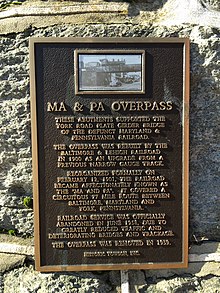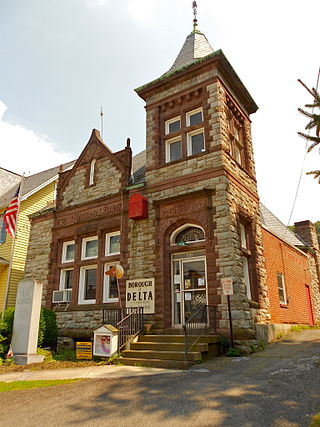
Delta is a borough in York County, Pennsylvania, United States, and one of the southernmost communities in Pennsylvania. The population was 706 at the 2020 census. It is served by the South Eastern School District which provides a public education.

The Baltimore and Ohio Railroad was the first common carrier railroad and the oldest railroad in the United States with its first section opening in 1830. Merchants from Baltimore, which had benefited to some extent from the construction of the National Road early in the century, wanted to do business with settlers crossing the Appalachian Mountains. The railroad faced competition from several existing and proposed enterprises, including the Albany-Schenectady Turnpike, built in 1797, the Erie Canal, which opened in 1825, and the Chesapeake and Ohio Canal.
The Pennsylvania Railroad, legal name The Pennsylvania Railroad Company, also known as the "Pennsy", was an American Class I railroad that was established in 1846 and headquartered in Philadelphia. It was named for the commonwealth in which it was established. At its peak in 1882, the Pennsylvania Railroad was the largest railroad, the largest transportation enterprise, and the largest corporation in the world.
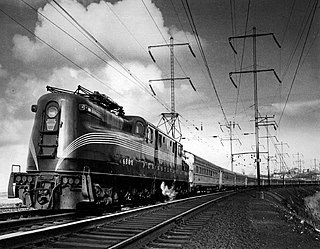
The Pennsylvania Railroad GG1 is a class of streamlined electric locomotives built for the Pennsylvania Railroad (PRR), in the northeastern United States. The class was known for its striking art deco shell, its ability to pull trains at up to 100 mph, and its long operating career of almost 50 years.

The Western Maryland Railway was an American Class I railroad (1852–1983) that operated in Maryland, West Virginia, and Pennsylvania. It was primarily a coal hauling and freight railroad, with a small passenger train operation.

The Maryland Midland Railway is a Class III short-line railroad operating approximately 63 miles of track in central Maryland. It was originally headquartered in the former Western Maryland Railway station in Union Bridge, Maryland: it has since moved to a new facility across from the old station. The railroad has been 87.4% owned by Genesee & Wyoming since 2008, with Lehigh Cement retaining a 12.6% interest.

The Northern Central Railway (NCRY) was a Class I Railroad in the United States connecting Baltimore, Maryland, with Sunbury, Pennsylvania, along the Susquehanna River. Completed in 1858, the line came under the control of the Pennsylvania Railroad (PRR) in 1861, when the PRR acquired a controlling interest in the Northern Central's stock to compete with the rival Baltimore and Ohio Railroad (B&O).

The York Railway is a shortline railroad operating 48 miles (77 km) of track in and near York, Pennsylvania. YRC was acquired by Genesee & Wyoming in 2002, has a capacity of 286,000, and has three interchanges: CSX ; East Penn Railroad ; Norfolk Southern.
The Stewartstown Railroad is a heritage railroad in Stewartstown, Pennsylvania. Chartered in 1884 by local interests in the Stewartstown area and opened in 1885, the Stewartstown Railroad survives today in very much original condition and retains its original corporate charter.
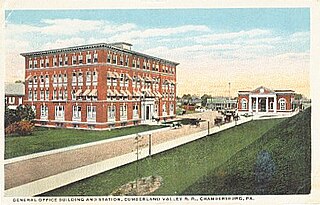
The Cumberland Valley Railroad was an early railroad in Pennsylvania, United States, originally chartered in 1831 to connect with Pennsylvania's Main Line of Public Works. Freight and passenger service in the Cumberland Valley in south central Pennsylvania from near Harrisburg to Chambersburg began in 1837, with service later extended to Hagerstown, Maryland, and then extending into the Shenandoah Valley to Winchester, Virginia. It employed up to 1,800 workers.

The Buffalo and Susquehanna Railroad was a railroad company that formerly operated in western and north central Pennsylvania and western New York. It was created in 1893 by the merger and consolidation of several smaller logging railroads. It operated independently until 1929, when a majority of its capital stock was purchased by the Baltimore and Ohio Railroad. At the same time, the B&O also purchased control of the neighboring Buffalo, Rochester, and Pittsburgh Railway. The Baltimore and Ohio officially took over operations of both roads in 1932.
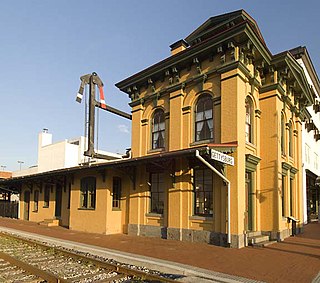
The Gettysburg Railroad was a railway line in Pennsylvania that operated from 1858 to 1870 over the 17-mile (27 km) main line from the terminus in Gettysburg to the 1849 Hanover Junction. After becoming the Susquehanna, Gettysburg & Potomac Railway line in 1870, the tracks between Gettysburg and Hanover Junction became part of the Hanover Junction, Hanover and Gettysburg Railroad in 1874, the Baltimore and Harrisburg Railway in 1886, and the Western Maryland Railway in 1917.
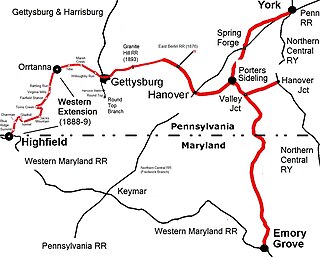
The Baltimore and Harrisburg Railway was a railroad that operated in Maryland and Pennsylvania in the 19th and early 20th centuries. The 59 miles (95 km) main line ran from Emory Grove, Maryland to Orrtanna, Pennsylvania, with a 6 miles (9.7 km) branch from Valley Junction, Pennsylvania to Hanover Junction, Pennsylvania; and later extensions to Highfield, Maryland and York, Pennsylvania.
The Walkersville Southern Railroad is a 6.72 mile (11 km) heritage railway in Walkersville, Maryland. running from MP 60.0 south of Woodsboro, MD to MP 66.72 just north of the intersection of Route 26 and U.S. Route 15 near Frederick, Maryland.

The Philadelphia and Baltimore Central Railroad (P&BC) was a railroad that operated in Pennsylvania and Maryland in the 19th and early 20th centuries. It operated a 110-mile (180 km) main line between West Philadelphia and Octoraro Junction, Maryland, plus several branch lines.

The Lancaster, Oxford and Southern Railway (LO&S) was a 3 ft narrow gauge railway that operated in southeastern Pennsylvania between 1912 and 1918, as a successor company following the bankruptcy of the Lancaster, Oxford and Southern Railroad. The main line connected Oxford and Peach Bottom, Pennsylvania.
The York and Peach Bottom Railway (Y&PB) was a 19th-Century 3 ft narrow gauge railroad in Pennsylvania. It operated freight and passenger trains between York and Delta.
The Maryland Central Railroad (MCRR) was a 19th-century 3 ft narrow gauge railroad in Maryland, with a small track section in Pennsylvania. It operated freight and passenger trains between Baltimore and Delta, Pennsylvania.
The Baltimore and Lehigh Railroad (B&L) was a 19th-century, 3 ft narrow gauge railroad in Maryland and Pennsylvania. It operated freight and passenger trains on its main line between Baltimore and York, Pennsylvania.
The Baltimore, Philadelphia and New York Railroad was a paper railroad of the 1870s, vaguely projected to construct a new line between Baltimore and New York via Philadelphia. It did very little construction work, except for a few miles of grading from Relay House, on the Northern Central Railroad, through Towson, Maryland to the Gunpowder River. It merged with the bankrupt Wilmington and Reading Railroad in 1875, but failed to attract further investment to complete its own line. The two railroads were both reorganized separately after foreclosures. Most of the grade was sold to the Baltimore and Delta Railway.













